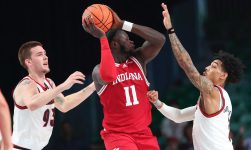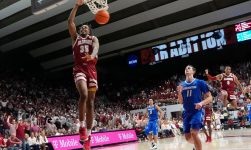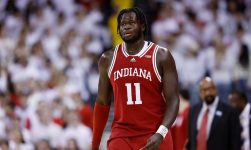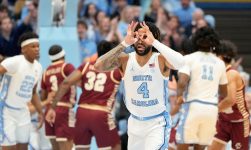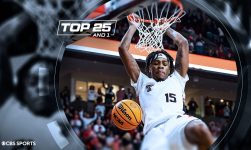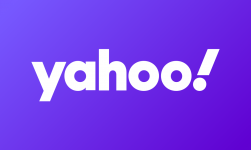Over the past year, North Carolina big man Armando Bacot has emerged as the poster child for college basketball players spurning the professional ranks in favor of staying in school to capitalize on their name, image and likeness potential while building a college legacy. His NIL portfolio reportedly exceeds $500,000, which is competitive to an NBA two-way contract of $508,891 or roughly half of the NBA’s rookie minimum salary.
But his daily life on campus as a Tar Heel legend is arguably more glamorous than life on an NBA two-way contract, which is where he may have been headed if he’d gone to the NBA Draft either of the past two years.
While Bacot has clearly capitalized on the newfound earnings potential afforded to big-name college stars in recent years, he did so without ever entering the transfer portal or testing the NBA Draft waters, which could have started a high-dollar bidding war.
With the May 11 deadline to enter the transfer portal passed and the May 31 deadline for players to withdraw from the NBA Draft and retain their college eligibility approaching, a handful of prospects have big decisions to make and big money at stake. Dozens will receive feedback from this week’s NBA Draft Combine over their professional outlook and use that information to decide whether to remain in the draft or return to college.
As they navigate that process, they will do so with a negotiating position that even Bacot, the face of NIL in men’s basketball, never fully pursued. On the one hand, there are professional options in the United States and abroad. Then, there are collegiate collectives that would love to have proven producers representing their schools. That dynamic is only heightened for players such as Julian Phillips of Tennessee and Arthur Kaluma of Creighton who have taken the additional step of entering the transfer portal while also negotiating the pre-draft process.
Oscar Tshiebwe and Drew Timme are trying to impress scouts at this weeks’ NBA Draft Combine.
Getty Images
“Players now have options,” said Jordan Gazdik, who consults directly for a number of college basketball’s top talents and their families, brokering NIL and collective deals. “You see it all the time now as players are announcing that they are going to the NBA Draft to test the waters, but they are also entering the transfer portal at the same time just to keep all their options open. NIL has allowed the value drivers of college sports – the athletes – to finally capitalize on their value and leverage the opportunities they have earned for themselves. Every good negotiation needs leverage.”
NIL provides leverage
Pursuing leverage is a strategy that was unavailable prior to the NIL era – at least in a monetary sense – and it allows a player to capitalize on their production. But there is a means to Bacot’s loyalty method as well, which is the relationship he’s developed with UNC fans while never wavering in his commitment to one of college basketball’s biggest brands by flirting with the draft or transfer portal.
“The reality is that since the NIL era started, it’s become easier for college stars to stay in school and establish stronger foundations in their local community, which will help them for the rest of their lives, still earn what they may earn on a two-way or rookie contract, hone their skills and go out the next year,” said Blake Lawrence, the CEO of OpenDorse, an NIL platform that facilitates hundreds of million dollars annually in deals for college athletes. “It’s fun. That’s the reality. There are many benefits that athletes have by aligning with blue-chip college basketball brands.”
It’s that reality which explains why Purdue center Zach Edey is entertaining the possibility of returning to college basketball next season with the Boilermakers. Though he surely could have attracted high-dollar offers by entering the portal as well, there is a sense of mutual loyalty between Edey and Purdue that made transferring implausible for the 7-foot-4 star.
“I would never do something like that to Purdue,” Edey said. “I owe Matt Painter the world, I owe (assistant) coach (Brandon) Brantley the world. I owe Purdue the world. I wouldn’t mess around and threaten to go to a different school. I would just never do that. It’s always been either Purdue or the NBA for me. There’s no other option.”
NIL experts agree there is no one-size-fits-all approach to navigating stay or go decisions for basketball players evaluating professional options. Instead, there are many factors to consider, such as a player’s platform and their pro potential.
For a player such as Bacot, who established a large social media platform closely tied to North Carolina, flirting with playing elsewhere could have negatively impacted his relationship with brands that specifically sought him because of his association with a college basketball mega-brand. But for a draft prospect oozing with potential and boasting only moderate collegiate production and a lesser social media following, such as Phillips from Tennessee, an earlier jump to the pros could be more sensible.
While frustration can be a natural reaction from some fans seeing players from their schools explore other options in a way that wouldn’t have been possible in a bygone era, industry leaders see it as a natural outgrowth of what has widely been termed as the “player empowerment era.”
“It’s definitely enticing. It’s definitely a factor in my decision.”
Purdue center Zach Edey on factoring NIL in his NBA Draft decision
“NIL naturally has a negative stigma and connotation,” Gazdik said. “Fans may think it’s ruining college sports as they know it, boosters may think the universities and collectives are begging them for money to waste. But if we take a step back and look at it, we can see the incredible gift that NIL is. Every great industry needs innovation and positive change to make it better for the whole. That’s what NIL is doing. It’s special to see the lives changed and the opportunities given to such hardworking athletes who work tirelessly to provide for those around them.”
Look no further than Miami guard Nijel Pack, who is going through the NBA’s pre-draft process this week and making a decision on his future after helping guide Miami to its first-ever Final Four. Just a year ago, Pack made headlines by accepting a widely publicized two-year, $800,000 NIL deal with a company backed by Miami booster John Ruiz as he transferred from Kansas State to play for the Hurricanes.
If Pack doesn’t get good feedback from NBA franchises this month, he can return to college knowing he’s in good financial shape. Prior to the NIL era, a player in need of a payday would’ve had no choice but to stay in the draft.
“Especially in the offseason, a lot of guys put in a lot of hours,” Pack told CBS Sports during the NCAA Tournament. “You’re getting a stipend and a scholarship, which is great, but what money do you have to live on after that? Basketball is basically a job. Guys should be able to [profit] off of that.”
In Edey’s case, steps are being taken to make that path to NIL profitability a bit simpler. Since Edey is Canadian, student visa restrictions kept him from earning NIL money while on U.S. soil. But he told reporters at the combine that plans are in the works for Edey to receive a different visa that will allow him to profit without going overseas.
“It’s definitely enticing,” Edey said. “It’s definitely a factor in my decision. It’s a thing where obviously you want to look out for yourself financially, and Purdue is going to help me do that if I was to come back.”
Show them the money
Still, there are potential pitfalls for players choosing to pursue a position of leverage as they decide between collegiate and professional options. Lawrence advocates for players to request to see the bank accounts of collectives before putting stock in promised dollars figures.
“I know that sounds intrusive or whatnot,” Lawrence said. “But that is the only way to confirm the realities of the market. If a collective is saying, ‘I would like to offer you $100,000 a year,’ ask to see their bank statement. These are athletes making life-changing decisions based on information that is oftentimes inaccurate and more often than not, completely false.”
Then, there is the issue of who athletes have surrounded themselves with as a major stay-or-go decision looms. Between agents, coaches, collectives, consultants, endorsers, family and friends, the choice can become convoluted by a variety of voices with competing agendas. It’s an element that Lawrence called “the hardest part right now” amid the evolving landscape of the NIL era.
“The only people that should assist student-athletes contemplating a move whether from one school to the other or college to the draft are individuals or entities that have done it before or have firsthand knowledge of dollars hitting bank accounts,” Lawrence said. “The majority of those influencing decisions are first-timers with no knowledge of what’s on the other side in the portal or the draft.”
Emotional factors at play
Another factor at play for players making their draft decisions over the coming weeks will be the aspirational element. It’s that side of every player who believes they are good enough to make a 15-man NBA roster and fulfill a lifelong goal. That self-belief can play a determining factor even if signs suggest a return to college and NIL payday could be the safer choice.
“Every athlete and family I have talked to recognizes that there is an analysis that needs to be made and a specific thought process regarding the financial situation of staying in school or going to the draft,” Gazdik said. “But for a kid that has trained every day since they were five years old to be in the NBA, when there is light at the end of the tunnel, for better or worse, a lot of quantitative thinking goes out the window. It becomes more emotional and passion-driven. That’s inspiring to see. These are your dreams, so let’s go chase them.”
Not every decision comes down to money. Sometimes, it’s about kicking the can down the road for another year and returning to school to develop, pursue a goal with your college team and then return to the professional pool later when a larger payday may await. Such was the case for Terquavion Smith, who decided after his freshman year to return to NC State for another season. Now, Smith is projected as a late first-round pick in CBS Sports mock drafts.
“It really didn’t have an impact on me going back to school,” Smith said of NIL. “I just felt that I wanted to go back, so I went back. NIL was new to me. I’d play for free, honestly. I just love the game. That just came about. But I’m grateful for it and thankful they created it. It helped me out in a lot of ways with my family. So I can’t complain about it.”
CBS Sports writer Kyle Boone in Chicago contributed to this report

